A New Perspective on the Applicability of Diffuse Reflectance Spectroscopy for Determining the Hematite Content of Fe-Rich Soils in the Tropical Margins of China
Abstract
:1. Introduction
2. Materials and Methods
2.1. Study Area and Sampling
2.2. Laboratory Procedures and Measurements
3. Results
3.1. Characteristics of the First Derivative of DRS Curves before and after Ignition
3.2. Characteristics of the Second Derivative of the DRS K-M Remission Functions before and after Ignition at 950 °C
3.3. Comparison of the Hematite Content Estimated by Redness before and after Ignition at 950 °C
4. Discussion
4.1. Relationships between DRS Parameters
4.2. Applicability of the Various Indices in Soils Developed on Different Parent Materials
5. Conclusions
Supplementary Materials
Author Contributions
Funding
Data Availability Statement
Acknowledgments
Conflicts of Interest
References
- Barrón, V.; Torrent, J. Evidence for a simple pathway to maghemite in Earth and Mars soils. Geochim. Cosmochim. Acta 2002, 66, 2801–2806. [Google Scholar] [CrossRef]
- Cornell, R.M.; Schwertmann, U. The Iron Oxides: Structure, Properties, Reactions, Occurences and Uses; John Wiley & Sons: Hoboken, NJ, USA, 2003. [Google Scholar]
- Jiang, Z.; Liu, Q.; Roberts, A.P.; Dekkers, M.J.; Barrón, V.; Torrent, J.; Li, S. The magnetic and color reflectance properties of hematite: From Earth to Mars. Rev. Geophys. 2022, 60, e2020RG000698. [Google Scholar] [CrossRef]
- Torrent, J.; Schwertmann, U.; Fechter, H.; Alferez, F. Quantitative relationships between soil color and hematite content. Soil Sci. 1983, 136, 354–358. [Google Scholar] [CrossRef]
- Stucki, J.W.; Goodman, B.A.; Schwertmann, U. Iron in Soils and Clay Minerals; Springer: Dordrecht, The Netherlands, 1988. [Google Scholar]
- Long, X.; Ji, J.; Balsam, W. Rainfall-dependent transformations of iron oxides in a tropical saprolite transect of Hainan Island, South China: Spectral and magnetic measurements. J. Geophys. Res. Earth Surf. 2011, 116, F03015. [Google Scholar] [CrossRef]
- Zhang, Y.G.; Ji, J.; Balsam, W.L.; Liu, L.; Chen, J. High resolution hematite and goethite records from ODP 1143, South China Sea: Co-evolution of monsoonal precipitation and El Niño over the past 600,000 years. Earth Planet. Sci. Lett. 2007, 264, 136–150. [Google Scholar] [CrossRef]
- Pan, H.-J.; Yu, P.-S.; Chen, M.-T. A marine sediment component interpretation based on diffuse reflectance spectrophotometry from northern South China Sea sediment core MD972148. Quat. Int. 2014, 333, 20–25. [Google Scholar] [CrossRef]
- Ji, J.; Balsam, W.; Chen, J. Mineralogic and climatic interpretations of the Luochuan loess section (China) based on diffuse reflectance spectrophotometry. Quat. Res. 2001, 56, 23–30. [Google Scholar] [CrossRef]
- Meng, Y.; Liu, X. Millennial-scale climate oscillations inferred from visible spectroscopy of a sediment core in Qarhan Salt Lake of Qaidam Basin between 40 and 10 cal ka BP. Quat. Int. 2018, 464, 336–342. [Google Scholar] [CrossRef]
- Lepre, C.J.; Olsen, P.E. Hematite reconstruction of Late Triassic hydroclimate over the Colorado Plateau. Proc. Natl. Acad. Sci. USA 2021, 118, e2004343118. [Google Scholar] [CrossRef] [PubMed]
- Zan, J.; Maher, B.A.; Yamazaki, T.; Fang, X.; Han, W.; Kang, J.; Hu, Z. Mid-Pleistocene links between Asian dust, Tibetan glaciers, and Pacific iron fertilization. Proc. Natl. Acad. Sci. USA 2023, 120, e2304773120. [Google Scholar] [CrossRef] [PubMed]
- Roberts, A.P.; Zhao, X.; Heslop, D.; Abrajevitch, A.; Chen, Y.-H.; Hu, P.; Jiang, Z.; Liu, Q.; Pillans, B.J. Hematite (α-Fe2O3) quantification in sedimentary magnetism: Limitations of existing proxies and ways forward. Geosci. Lett. 2020, 7, 8. [Google Scholar] [CrossRef]
- Scheinost, A.C.; Chavernas, A.; Barron, V.; Torrent, J. Use and limitations of second-derivative diffuse reflectance spectroscopy in the visible to near-infrared range to identify and quantify Fe oxide minerals in soils. Clays Clay Miner. 1998, 46, 528–536. [Google Scholar] [CrossRef]
- Deaton, B.C.; Balsam, W.L. Visible spectroscopy—A rapid method for determining hematite and goethite concentration in geological materials. J. Sediment. Res. 1991, 61, 628–632. [Google Scholar] [CrossRef]
- Cao, W.; Jiang, Z.; Gai, C.; Barrón, V.; Torrent, J.; Zhong, Y.; Liu, Q. Re-Visiting the Quantification of Hematite by Diffuse Reflectance Spectroscopy. Minerals 2022, 12, 872. [Google Scholar] [CrossRef]
- Liu, Q.S.; Torrent, J.; Barrón, V.; Duan, Z.Q.; Bloemendal, J. Quantification of hematite from the visible diffuse reflectance spectrum: Effects of aluminium substitution and grain morphology. Clay Miner. 2011, 46, 137–147. [Google Scholar] [CrossRef]
- Hu, P.; Jiang, Z.; Liu, Q.; Heslop, D.; Roberts, A.P.; Torrent, J.; Barrón, V. Estimating the concentration of aluminum-substituted hematite and goethite using diffuse reflectance spectrometry and rock magnetism: Feasibility and limitations. J. Geophys. Res. Solid Earth 2016, 121, 4180–4194. [Google Scholar] [CrossRef]
- Jiang, Z.; Liu, Q. Quantification of hematite and its climatic significances. Quat. Sci. 2016, 36, 676–689. [Google Scholar]
- Torrent, J.; Barrón, V. The visible diffuse reflectance spectrum in relation to the color and crystal properties of hematite. Clays Clay Miner. 2003, 51, 309–317. [Google Scholar] [CrossRef]
- Ji, J.; Chen, J.; Balsam, W.; Liu, L.; Chen, Y.; Zhao, L.; Zhou, W. Quantitative analysis of hematite and goethite in the Chines loess-paleosol sequences and its implication for dry and humid variability. Quat. Sci. 2007, 27, 221–229. [Google Scholar]
- Smith, M.J.; Stevens, T.; MacArthur, A.; Malthus, T.J.; Lu, H. Characterising Chinese loess stratigraphy and past monsoon variation using field spectroscopy. Quat. Int. 2011, 234, 146–158. [Google Scholar] [CrossRef]
- Meng, X.; Li, G.K.; Long, X.; Li, S.; Ji, J. Quantifying soil goethite/hematite ratios: A new method based on diffuse reflectance spectra. Geophys. Res. Lett. 2023, 50, e2022GL102280. [Google Scholar] [CrossRef]
- Liu, Q.; Roberts, A.P.; Torrent, J.; Horng, C.-S.; Larrasoaña, J.C. What do the HIRM and S-ratio really measure in environmental magnetism? Geochem. Geophys. Geosyst. 2007, 8, Q09011. [Google Scholar] [CrossRef]
- Hao, Q.; Oldfield, F.; Bloemendal, J.; Torrent, J.; Guo, Z. The record of changing hematite and goethite accumulation over the past 22 Myr on the Chinese Loess Plateau from magnetic measurements and diffuse reflectance spectroscopy. J. Geophys. Res. Solid Earth 2009, 114, B12101. [Google Scholar] [CrossRef]
- Hu, P.; Liu, Q.; Torrent, J.; Barrón, V.; Jin, C. Characterizing and quantifying iron oxides in Chinese loess/paleosols: Implications for pedogenesis. Earth Planet. Sci. Lett. 2013, 369–370, 271–283. [Google Scholar] [CrossRef]
- Szeberényi, J.; Kovács, J.; Bradák, B.; Barta, G.; Csonka, D.; Medveďová, A.; Roštínský, P.; Kiss, K.; Varga, G. Experiencing new perspectives in the application of reflectance spectroscopy in loess research. Quat. Int. 2020, 552, 36–49. [Google Scholar] [CrossRef]
- Torrent, J.; Barrón, V.; Liu, Q. Magnetic enhancement is linked to and precedes hematite formation in aerobic soil. Geophys. Res. Lett. 2006, 33, L02401. [Google Scholar] [CrossRef]
- Zhao, L.; Hong, H.; Fang, Q.; Yin, K.; Wang, C.; Li, Z.; Torrent, J.; Cheng, F.; Algeo, T.J. Monsoonal climate evolution in southern China since 1.2 Ma: New constraints from Fe-oxide records in red earth sediments from the Shengli section, Chengdu Basin. Palaeogeogr. Palaeoclimatol. Palaeoecol. 2017, 473, 1–15. [Google Scholar] [CrossRef]
- Zhao, L.; Hong, H.; Fang, Q.; Algeo, T.J.; Wang, C.; Li, M.; Yin, K. Potential of VNIR spectroscopy for prediction of clay mineralogy and magnetic properties, and its paleoclimatic application to two contrasting Quaternary soil deposits. Catena 2020, 184, 104239. [Google Scholar] [CrossRef]
- Liu, C.; Dupont-Nivet, G.; Wang, W.; Deng, C. Magnetic response to pedogenesis in aerobic soils of different weathering degree. Palaeogeogr. Palaeoclimatol. Palaeoecol. 2021, 567, 110240. [Google Scholar] [CrossRef]
- Liu, C.; Qin, H.; Ferré, E.C.; Wang, W.; He, K.; Deng, C. Importance of hematite self-reversal in Al-rich soils magnetostratigraphy: Revisiting the Damei red soil sequence in the Bose basin, Southern China. J. Geophys. Res. Solid Earth 2022, 127, e2021JB023165. [Google Scholar] [CrossRef]
- Guo, S.; Cai, Y.; Ren, J.; Guan, Y.; Xin, D.; Long, X. Formation and migration of magnetic particles associated with iron oxide transformation at a hillslope scale. Catena 2021, 197, 104944. [Google Scholar] [CrossRef]
- Lü, B.; Liu, X. Magnetic properties of latosols from Zhangpu County, Fujian Province and their environmental significance. J. Earth Environ. 2021, 12, 19–31. [Google Scholar]
- Tang, J.; Lü, B.; Liu, X.; Du, J.; Chen, T.; Li, J. Chromaticity characteristics of soil profiles in the coastal areas of Fujian and Guangdong, southern China and their climatic significance. Quat. Int. 2023, 649, 38–45. [Google Scholar] [CrossRef]
- Zhu, M.; Lü, B.; Guo, Y. Comparison of hematite and goethite contents in aeolian deposits in different climate zones based on diffuse reflectance spectroscopy and chromaticity methods. Spectrosc. Spect. Anal. 2022, 42, 1684–1690. [Google Scholar]
- Hu, X.-F.; Du, Y.; Liu, X.-J.; Zhang, G.-L.; Jiang, Y.; Xue, Y. Polypedogenic case of loess overlying red clay as a response to the Last Glacial–Interglacial cycle in mid-subtropical Southeast China. Aeolian Res. 2015, 16, 125–142. [Google Scholar] [CrossRef]
- Lu, J.; Long, X.; Li, X.; Ji, J.; Qiang, X.; Song, Y. Topography-dependent formation and transformation of lithogenic and pedogenic iron oxides on a volcano under a tropical monsoon climate. Catena 2022, 217, 106521. [Google Scholar] [CrossRef]
- Hyland, E.; Sheldon, N.; Van Der Voo, R.; Badgley, C.; Abrajevitch, A. A new paleoprecipitation proxy based on soil magnetic properties: Implications for expanding paleoclimate reconstructions. GSA Bull. 2015, 127, 975–981. [Google Scholar] [CrossRef]
- Maxbauer, D.P.; Feinberg, J.M.; Fox, D.L. Magnetic mineral assemblages in soils and paleosols as the basis for paleoprecipitation proxies: A review of magnetic methods and challenges. Earth Sci. Rev. 2016, 155, 28–48. [Google Scholar] [CrossRef]
- Barranco, F.T.; Balsam, W.L.; Deaton, B.C. Quantitative reassessment of brick red lutites: Evidence from reflectance spectrophotometry. Mar. Geol. 1989, 89, 299–314. [Google Scholar] [CrossRef]
- Canton, L.C.; Souza Júnior, I.G.; Silva, L.S.; Marques Júnior, J.; Costa, A.C.S. Identification and quantification of iron oxides by diffuse reflectance spectroscopy with Praying Mantis accessory and integration sphere. Catena 2021, 196, 104899. [Google Scholar] [CrossRef]
- Schwertmann, U. Occurrence and formation of iron oxides in various pedoenvironments. In Iron in Soils and Clay Minerals; Stucki, J.W., Goodman, B., Schwertmann, U., Eds.; Springer: Dordrecht, The Netherlands, 1988; pp. 267–308. [Google Scholar]
- Silva, L.S.; Marques Júnior, J.; Barrón, V.; Gomes, R.P.; Bortoli Teixeira, D.; Siqueira, D.S.; Vasconcelos, V. Spatial variability of iron oxides in soils from Brazilian sandstone and basalt. Catena 2020, 185, 104258. [Google Scholar] [CrossRef]
- Singh, B.; Gilkes, R.J. Properties and distribution of iron oxides and their association with minor elements in the soils of south-western Australia. J. Soil Sci. 1992, 43, 77–98. [Google Scholar] [CrossRef]
- Jiang, Z.; Liu, Q.; Colombo, C.; Barrón, V.; Torrent, J.; Hu, P. Quantification of Al-goethite from diffuse reflectance spectroscopy and magnetic methods. Geophys. J. Int. 2014, 196, 131–144. [Google Scholar] [CrossRef]
- Wang, M.; Lu, H. Age, geochemical composition and their paleoclimatic implications of the basalt in Leizhou Peninsula, Southern China. Quat. Sci. 2019, 39, 1071–1082. [Google Scholar]
- Zhu, H.J.; Chen, J.F.; Chen, S.L. Soli Geography; Higher Education Press: Beijing, China, 2019. [Google Scholar]
- Nesbitt, H.W.; Young, G.W. Early Proterozoic climates and plate motions inferred from major element chemistry of lutites. Nature 1982, 299, 715–717. [Google Scholar] [CrossRef]
- Fu, H.-J.; Jian, X.; Liang, H.-H. Research progress of sediment indicators and methods for evaluation of silicate chemical weathering intensity. J. Palaeogeogr. 2021, 23, 1192–1209. [Google Scholar]
- Su, N.; Yang, S.-Y.; Wang, X.-D.; Bi, L.; Yang, C.F. Magnetic parameters indicate the intensity of chemical weathering developed on igneous rocks in China. Catena 2015, 133, 328–341. [Google Scholar] [CrossRef]
- Bou-Orm, N.; AlRomaithi, A.A.; Elrmeithi, M.; Ali, F.M.; Nazzal, Y.; Howari, F.M.; Al Aydaroos, F.A. Advantages of first-derivative reflectance spectroscopy in the VNIR-SWIR for the quantification of olivine and hematite. Planet. Space Sci. 2020, 188, 104957. [Google Scholar] [CrossRef]
- Zou, X.; Chen, T.; Zhang, P.; Chen, D.; Liu, H.; Qing, C. Structural characteristic of natural goethite by thermal treatment. J. Chin. Ceram. Soc. 2013, 41, 1442–1446. [Google Scholar]
- Yu, M.; Wang, X. A discussion on color change mechanism of red aeolian sand in Pingtan Island, Fujian Province. J. Subtrop. Resour. Environ. 2018, 13, 1–8. [Google Scholar]
- Wiriyakitnateekul, W.; Suddhiprakarn, A.; Kheoruenromne, I.; Smirk, M.N.; Gilkes, R.J. Iron oxides in tropical soils on various parent materials. Clay Miner. 2007, 42, 437–451. [Google Scholar] [CrossRef]
- Hao, Q.; Guo, Z. Quantitative measurements on the paleo-weathering intensity of the loess-soil sequences and implication on paleomonsoon. Sci. China Ser. D Earth Sci. 2001, 44, 566–576. [Google Scholar] [CrossRef]
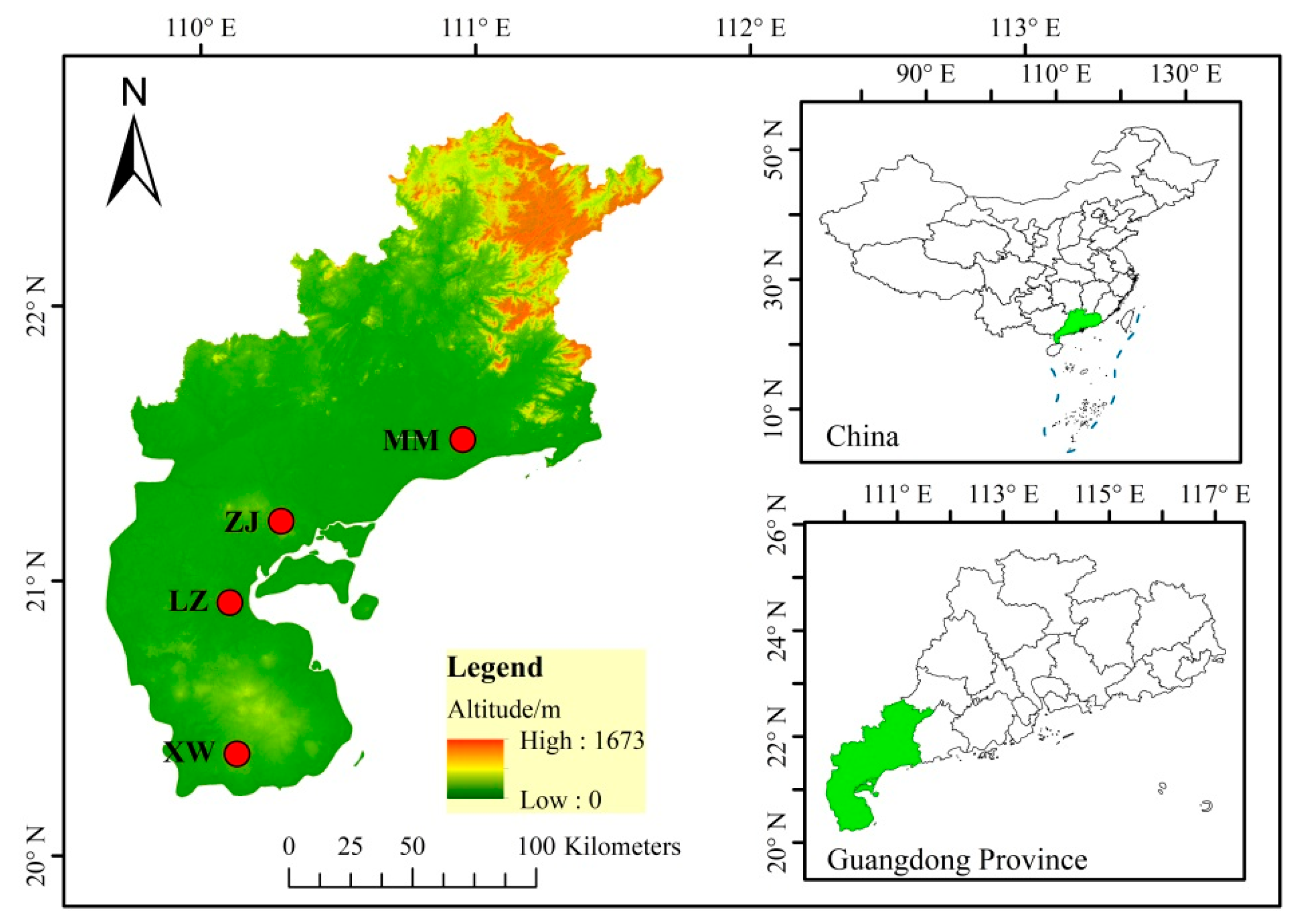
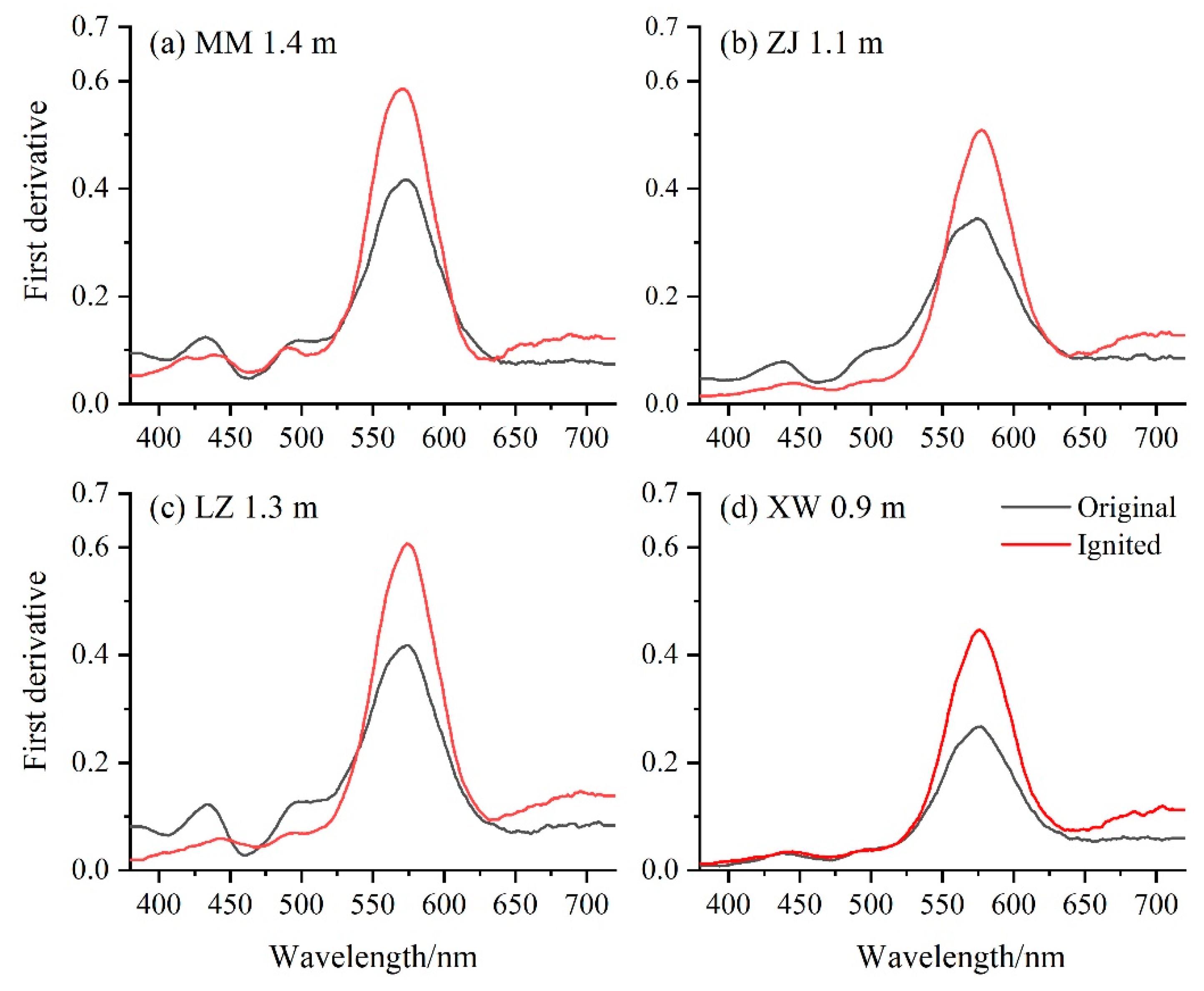
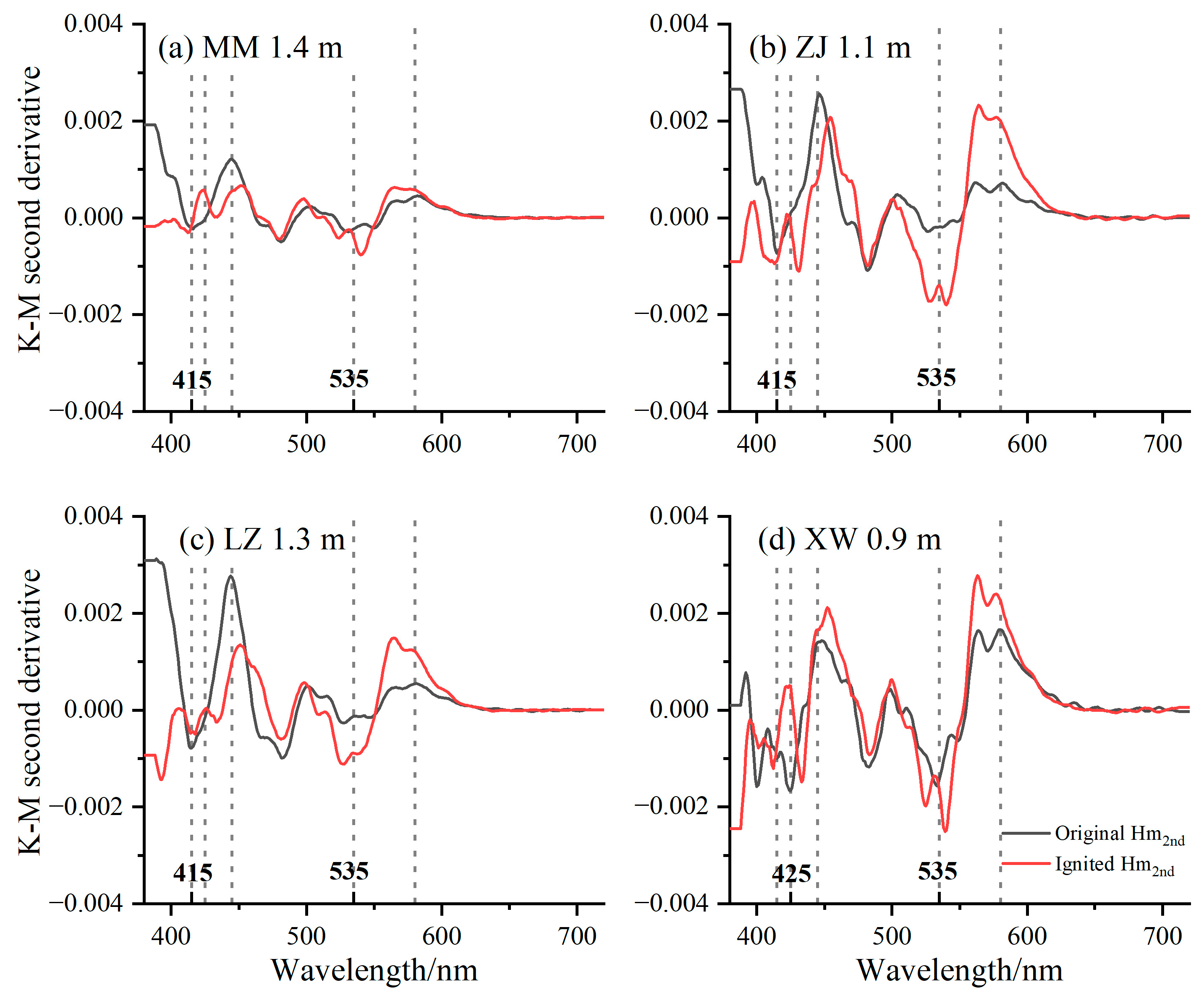
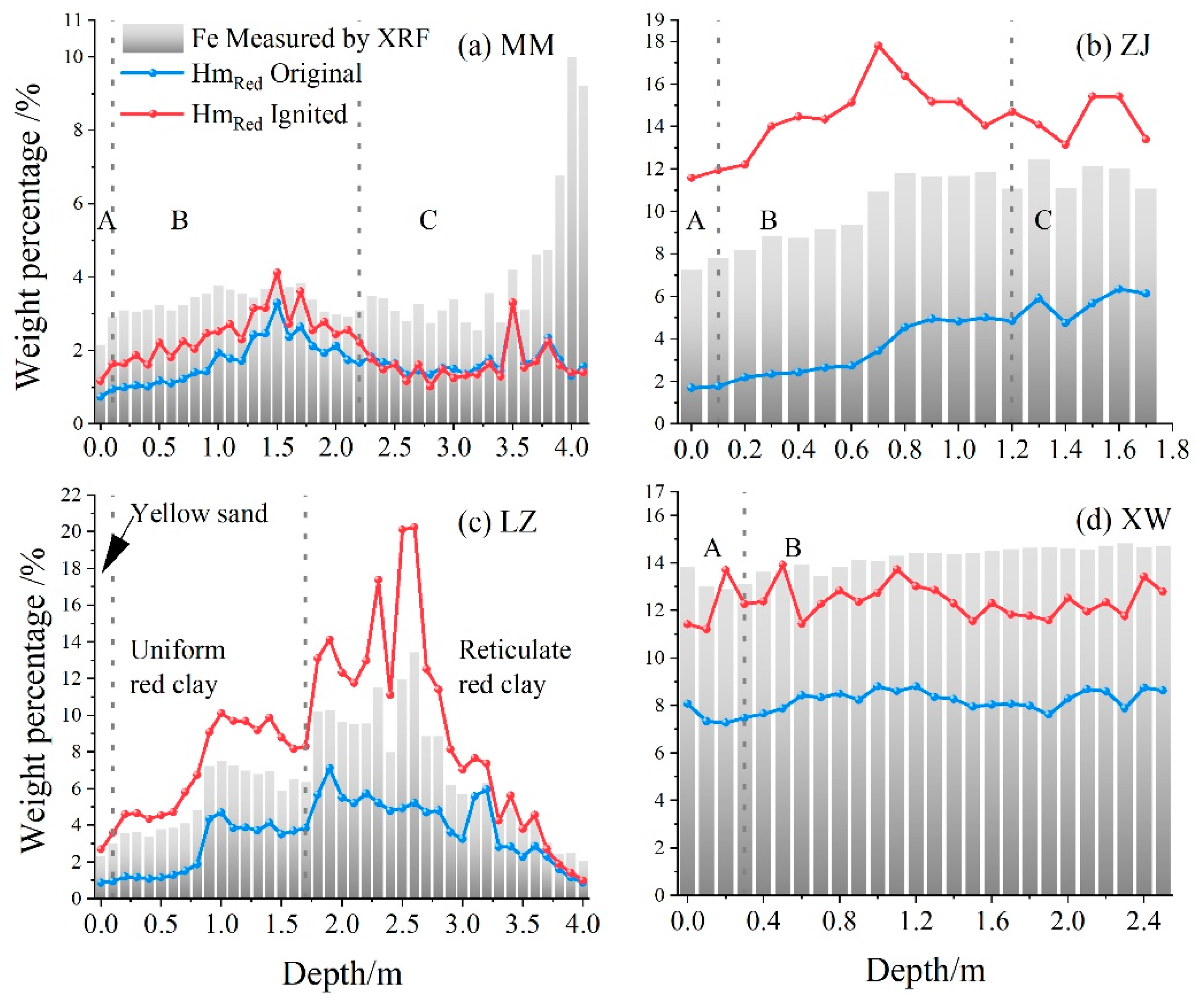
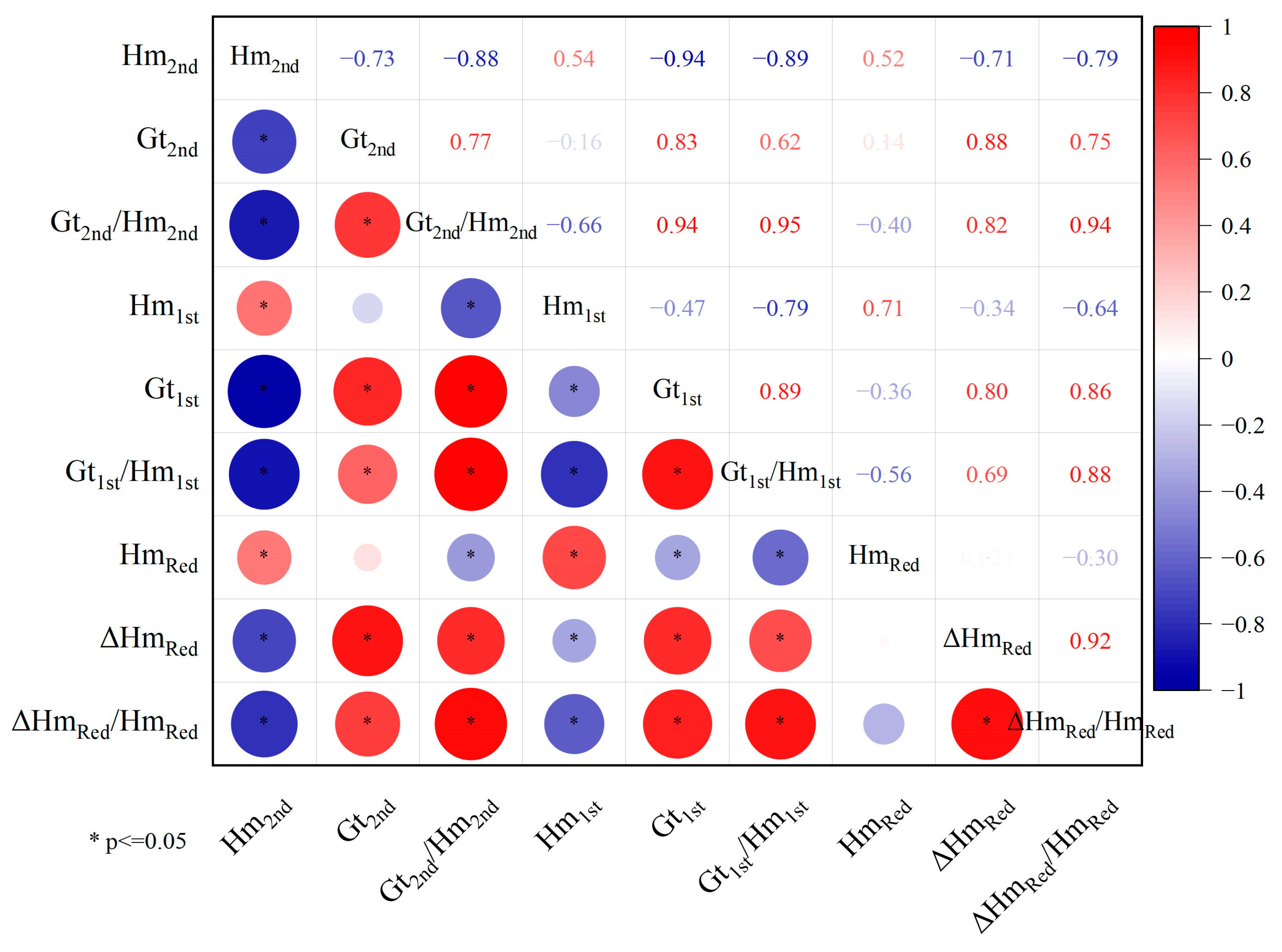

| Profile | Horizon | Depth/m | Munsell Color Chart | Quartz Particles | Texture |
|---|---|---|---|---|---|
| MM | A | 0–0.1 | 7.5YR4/6 | Fine, Fewer | Loose |
| B | 0.1–2.2 | 2.5YR4/8 | Coarse, Abundant | Sticky | |
| C | 2.3–4.1 | 5R5/6 | Coarse, Abundant | Sticky | |
| ZJ | A | 0–0.1 | 5YR3/3 | Fewer | Loose |
| B | 0.1–1.2 | 5YR4/6 | Fewer | Sticky | |
| C | 1.3–1.7 | 2.5YR4/8 | Fewer | Sticky | |
| LZ | Yellow Sand | 0–0.1 | 10YR6/8 | Fewer | Loose |
| Uniform Red Clay | 0.1–1.7 | 2.5YR4/8 | Fewer | Sticky | |
| Reticulate Red Clay | 1.7–4 | 2.5YR5/8; 2.5YR8/4 | Fewer | Sticky (1.7–3.2 m) Loose (3.2–4 m) | |
| XW | A | 0–0.3 | 5YR3/4 | Fewer | Sticky |
| B | 0.3–2.5 | 2.5YR3/4 | Fewer | Sticky |
| Profile | Latitude/° | Longitude/° | Parent Material | Altitude/m | Thickness/m | MAT/°C | MAP/mm |
|---|---|---|---|---|---|---|---|
| MM | 21.540 | 110.929 | Granite | 34.7 | 4.1 | 23.5 | 1762.2 |
| ZJ | 21.208 | 110.287 | Fine sandstone | 43.8 | 1.7 | 23.5 | 1731.4 |
| LZ | 20.948 | 110.091 | Unconsolidated sediment | 43.0 | 4.0 | 23.2 | 1623.9 |
| XW | 20.409 | 110.139 | Basalt | 75.2 | 2.5 | 23.8 | 1428.4 |
| Parameters | Abbreviation |
|---|---|
| Peak height of the first-order derivative curve at 575 nm | Hm1st |
| Peak height of the first-order derivative curve at 435 nm | Gt1st |
| Amplitude of the second-order derivative curve of the Kubelka–Munk remission functions at wavelengths of 535–590 nm | Hm2nd |
| Amplitude of the second-order derivative curves of the Kubelka–Munk remission functions at wavelengths of 405–450 nm | Gt2nd |
| Percentage of red band (630–700 nm) in the visible light band (400–700 nm) | Redness |
| Hematite content determined using calibration Equation (1) | HmRed |
| Weight percentage of Fe2O3 measured using X-ray fluorescence (XRF) relative to the total Fe content | Fe2O3/% |
| Hematite content indicated by the HmRed difference value before and after ignition | ΔHmRed |
| Profile | MM | ZJ | LZ | XW | |||||||
|---|---|---|---|---|---|---|---|---|---|---|---|
| Horizon | A | B | C | A | B | C | Yellow sand | Uniform red clay | Reticulate red clay | A | B |
| Original χ | 12.30 | 13.82 | 7.64 | 175.60 | 178.12 | 150.00 | 18.30 | 21.56 | 7.55 | 880.67 | 549.23 |
| Ignited χ | −0.54 | 0.08 | 1.89 | 3.68 | 5.97 | 6.26 | −1.07 | 0.76 | 3.65 | 12.16 | 12.91 |
| Profile | CIA | Ba Index | Fe2O3/% | Hm2nd | Hm1st | HmRed | Hm2nd/(Gt2nd + Hm2nd) | Hm1st/(Hm1st + Gt1st) |
|---|---|---|---|---|---|---|---|---|
| MM | 88.318 | 0.917 | 3.714 | 0.00071 | 0.380 | 1.702 | 0.400 | 0.756 |
| LZ | 86.382 | 0.121 | 6.285 | 0.00079 | 0.400 | 3.438 | 0.227 | 0.748 |
| ZJ | 90.130 | 0.076 | 10.411 | 0.00084 | 0.300 | 4.010 | 0.201 | 0.763 |
| XW | 97.552 | 0.021 | 14.168 | 0.00282 | 0.263 | 8.172 | 0.360 | 0.876 |
Disclaimer/Publisher’s Note: The statements, opinions and data contained in all publications are solely those of the individual author(s) and contributor(s) and not of MDPI and/or the editor(s). MDPI and/or the editor(s) disclaim responsibility for any injury to people or property resulting from any ideas, methods, instructions or products referred to in the content. |
© 2024 by the authors. Licensee MDPI, Basel, Switzerland. This article is an open access article distributed under the terms and conditions of the Creative Commons Attribution (CC BY) license (https://creativecommons.org/licenses/by/4.0/).
Share and Cite
Li, J.; Lü, B.; Chen, T.; Liu, X.; Tang, J.; Yan, H. A New Perspective on the Applicability of Diffuse Reflectance Spectroscopy for Determining the Hematite Content of Fe-Rich Soils in the Tropical Margins of China. Minerals 2024, 14, 242. https://doi.org/10.3390/min14030242
Li J, Lü B, Chen T, Liu X, Tang J, Yan H. A New Perspective on the Applicability of Diffuse Reflectance Spectroscopy for Determining the Hematite Content of Fe-Rich Soils in the Tropical Margins of China. Minerals. 2024; 14(3):242. https://doi.org/10.3390/min14030242
Chicago/Turabian StyleLi, Jiawei, Bin Lü, Tianyuan Chen, Xin Liu, Jinmeng Tang, and Hui Yan. 2024. "A New Perspective on the Applicability of Diffuse Reflectance Spectroscopy for Determining the Hematite Content of Fe-Rich Soils in the Tropical Margins of China" Minerals 14, no. 3: 242. https://doi.org/10.3390/min14030242





